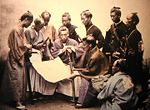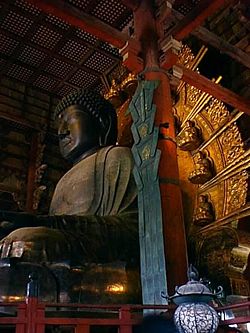Nara period
 History of Japan |
|---|
|
|
|
Glossary |
The Nara period (奈良時代 Nara-jidai) of the history of Japan covers the years from about AD 710 to 784. Empress Genmei (元明天皇 Gemmei Tennō) established the capital of ??? Heijō-kyō (平城京, present-day Nara). Except for 5 years (740-745), when the capital was briefly moved again, it remained the capital of Japanese civilization until Emperor Kammu (桓武天皇 Kammu Tennō) established a new capital Nagaoka-kyō (長岡京) at Nagaoka in 784 before moving to Heian-kyō (平安京), or Kyoto (京都), a decade later in 794.
Most of Japanese society during this period was agricultural in nature, centered around villages. Most of the villagers followed the Shinto religion, based around the worship of natural and ancestral spirits (kami).
The capital at Nara was modeled after Chang'an (長安, present-day Xi'an, 西安), the capital city of Tang China (唐). In many other ways, the Japanese upper classes patterned themselves after the Chinese, including adopting Chinese written characters (Japanese: kanji, 漢字) and the religion of Buddhism.
Nara period literature
Concentrated efforts by the imperial court to record and document its history produced the first works of Japanese literature during the Nara period. Works such as the Kojiki (古事記) and the Nihon shoki (日本書紀) were political in nature, used to record and therefore justify and establish the supremacy of the rule of the emperors within Japan.
With the spread of written language, the writing of Japanese poetry, known in Japanese as waka (和歌), began. Over time, personal collections were referenced to establish the first large collection of Japanese poetry known as Man'yōshū (万葉集) sometime after 759. Chinese characters were used to express sounds of Japanese until kana were invented. The Chinese characters used to express the sounds of Japanese are known as man'yōgana (万葉仮名).
Economic, social, and administrative developments
Before the Taihō Code (大宝律令 Taihō-ritsuryō) was established, the capital was customarily moved after the death of an emperor because of the ancient belief that a place of death was polluted. Reforms and bureaucratization of government led to the establishment of a permanent imperial capital at Heijō-kyō (平城京), or Nara, in AD 710. It is to be noted that the capital was moved shortly (for political reasons that time) between 740 and 745, to Kunikyo (恭仁京, present-day Kamo) between 740 and 744, to Shigarakinomiya (紫香楽宮, present-day Shigaraki) in 744 and Naniwa-kyo (難波京, present-day Osaka) in 744-745, but was moved back to Nara in 745. The capital at Nara, which gave its name to the new period, was styled after the grand Chinese Tang Dynasty (唐, 618–907) capital at Chang'an (長安). Nara was Japan's first truly urban center. It soon had a population of 200,000 (representing nearly 4% of the country's population) and some 10,000 people worked in government jobs.
Economic and administrative activity increased during the Nara period. Roads linked Nara to provincial capitals, and taxes were collected more efficiently and routinely. Coins were minted, if not widely used. Outside the Nara area, however, there was little commercial activity, and in the provinces the old Shōtoku land reform systems declined. By the mid-eighth century, shōen (荘園, landed estates), one of the most important economic institutions in medieval Japan, began to rise as a result of the search for a more manageable form of landholding. Local administration gradually became more self-sufficient, while the breakdown of the old land distribution system and the rise of taxes led to the loss or abandonment of land by many people who became the "wave people," or rōnin (浮浪人 or 浪人, see Glossary). Some of these formerly "public people" were privately employed by large landholders, and "public lands" increasingly reverted to the shōen.
Factional fighting at the imperial court continued throughout the Nara period. Imperial family members, leading court families, such as the Fujiwara (藤原), and Buddhist priests all contended for influence. Earlier this period, Prince Nagaya seized power at the court after the death of Fujiwara no Fuhito. Fuhito was succeeded by four sons, Muchimaro, Umakai, Fusasaki, and Maro. They put Emperor Shomu, the prince by Fuhito's daughter, on the throne. In 729, they arrested Nagaya and regained control. However, as the first outbreak of smallpox spread from Kyushu in 735, all four brothers were killed two years later, resulting in temporary shrinking of Fujiwara's dominance. It is without doubt that the Emperor was heavily shocked to this disaster, and he moved the palace three times in only five years since 740, until he eventually returned to Nara. In the late Nara period, financial burdens on the state increased, and the court began dismissing nonessential officials. In 792 universal conscription was abandoned, and district heads were allowed to establish private militia forces for local police work. Decentralization of authority became the rule despite the reforms of the Nara period. Eventually, to return control to imperial hands, the capital was moved in 784 to Nagaoka-kyō (長岡京) and in 794 to Heian-kyō (平安京, Capital of Peace and Tranquility), about twenty-six kilometers north of Nara. By the late eleventh century, the city was popularly called Kyoto (京都, capital city), the name it has had ever since.
Cultural developments and the establishment of Buddhism

Some of Japan's literary monuments were written during the Nara period, including the Kojiki (古事記) and Nihon shoki (日本書紀), the first national histories, compiled in 712 and 720 respectively; the Man'yōshū (万葉集, Collection of Ten Thousand Leaves), an anthology of poems; and the Kaifūsō (懐風藻, Fond Recollections of Poetry), an anthology written in Chinese by Japanese emperors and princes.
Another major cultural development of the era was the permanent establishment of Buddhism. Buddhism was introduced by Baekje in the sixth century, but had a mixed reception until the Nara period, when it was heartily embraced by Emperor Shōmu (聖武天皇 Shōmu Tennō). Shōmu and his Fujiwara consort were fervent Buddhists and actively promoted the spread of Buddhism, making it the "guardian of the state" and a way of strengthening Japanese institutions.
During Shōmu's reign, the Tōdai-ji (東大寺, Great Eastern Temple) was built, and within it was placed the Buddha Dainichi (Great Sun Buddha), a sixteen-metre-high, gilt-bronze statue. This Buddha was identified with the Sun Goddess, and a gradual syncretism of Buddhism and Shinto ensued. Shōmu declared himself the "Servant of the Three Treasures" of Buddhism: the Buddha, the law or teachings of Buddhism, and the Buddhist community.
The central government also established temples called kokubunji (国分寺) in the provinces. The Tōdaiji was the kokubunji of Yamato Province (大和国, present-day Nara Prefecture, 奈良県).
Although these efforts stopped short of making Buddhism the state religion, Nara Buddhism heightened the status of the imperial family. Buddhist influence at court increased under the two reigns of Shōmu's daughter. As Empress Kōken (孝謙天皇 Kōken Tennō, r. 749-758) she brought many Buddhist priests into court. Kōken abdicated in 758 on the advice of her cousin, Fujiwara no Nakamaro (藤原 仲麻呂). When the retired empress came to favor a Buddhist faith healer named Dokyo (道鏡), Nakamaro rose up in arms in 764 but was quickly crushed. Kōken charged the ruling emperor with colluding with Nakamaro and had him deposed. Kōken reascended the throne as Empress Shōtoku (称徳天皇 Shōtoku Tennō, r. 764–770). The empress commissioned the printing of 1 million prayer charms—the Hyakumanto dharani (百万塔陀羅尼) —many examples of which survive. The small scrolls, dating from 770, are among the earliest printed works in the world. Shōtoku had the charms printed to placate the Buddhist clergy. She may even have wanted to make Dokyo emperor, but she died before she could act. Her actions shocked Nara society and led to the exclusion of women from imperial succession and the removal of Buddhist priests from positions of political authority.
Many of the Japanese artworks and imported treasures from other countries during the era of Emperors Shomu and Shotoku are archived in Shosoin of Tōdai-ji temple. They are called Shōsōin treasures, and illustrate the cosmopolitan culture also known as Tempyo culture. Imported treasures show various influences of Silk Road areas, including China, Korea, India, and Islamic Empire. Also, Shosoin stores more than 10,000 paper documents so-called Shōsōin documents(正倉院文書). These are records written in the reverse side of the sutra or in the wrapping of imported items, and survivied as a result of reusing wasted official documents. Shōsōin documents contribute greatly to the research of Japanese political and social systems of the Nara period, while they even indicate the development of Japanese writing systems (such as katakana).
International relations
The Nara court aggressively imported Chinese civilization by sending diplomatic envoys to the Tang (唐) court every twenty years (known as Kentō-shi, 遣唐使). Many Japanese students, both lay and Buddhist priests, studied in Chang'an (長安) and Luoyang (洛陽). One student named Abe no Nakamaro (阿倍 仲麻呂) passed the Chinese civil examination to be appointed to governmental posts in China. He served as Governor-General in Annam (安南) or Chinese Vietnam from 761 through 767. Many students who returned to their homeland were promoted to high government posts like Kibi no Makibi (吉備 真備).
Tang China never sent official envoys to Japan, for Japanese kings, or emperors as they styled themselves, did not seek investiture from the Chinese emperor. A local Chinese government in Lower Yangzi Valley sent a mission to Japan to return Japanese envoys who entered China through Balhae (渤海). The Chinese local mission could not return home due to the rebellion of An Lu Shan, ending up to be naturalized in Japan.
Relations with the Korean kingdom of Silla (新羅) were initially peaceful, with regular diplomatic exchanges. But the rise of Balhae north of Silla destabilized the Japan-Silla relations. Balhae sent its first mission in 728 to Nara, which welcomed them as the successor to Goguryeo (高句麗), with which Japan was allied until Silla unified the Three Kingdoms of Korea. The friendly diplomatic and commercial intercourse with Balhae continued until the Korean kingdom was conquered by the Khitan (契丹, or Liao Dynasty, 遼) in the tenth century. Relations with Silla deteriorated as it strengthened ties with Tang.
Event
- 710: Japan's capital is moved from Asuka to Nara, modeled after China's capital Xi'an
- 712: The collection of tales Kojiki (record of ancient times)
- 720: The collection of tales Nihonshoki (history of Japan)
- 743: Emperor Shōmu founds the temple Tōdaiji in Nara with a colossal Buddha inside
- 759: The poetic anthology Man'yōshū ("Collection of Myriad Leaves")
- 784: The emperor moves the capital to Nagaoka
- 788: The Buddhist monk Saichō founds the monastery of Mt Hiei, near Kyoto, which becomes a vast ensemble of temples
ReferencesISBN links support NWE through referral fees
- This article contains material from the Library of Congress Country Studies, which are United States government publications in the public domain.
- Japan
< Asuka period | History of Japan | Heian period >
ar:فترة نارا de:Nara-Zeit fr:Époque de Nara he:תקופת נארה id:Zaman Nara ja:奈良時代 pl:Nara (okres) ro:Era Nara fi:Nara-kausi pt:Período Nara sv:Naraperioden th:ยุคนารา uk:Період Нара zh:奈良時代 ru:Период Нара
Credits
New World Encyclopedia writers and editors rewrote and completed the Wikipedia article in accordance with New World Encyclopedia standards. This article abides by terms of the Creative Commons CC-by-sa 3.0 License (CC-by-sa), which may be used and disseminated with proper attribution. Credit is due under the terms of this license that can reference both the New World Encyclopedia contributors and the selfless volunteer contributors of the Wikimedia Foundation. To cite this article click here for a list of acceptable citing formats.The history of earlier contributions by wikipedians is accessible to researchers here:
The history of this article since it was imported to New World Encyclopedia:
Note: Some restrictions may apply to use of individual images which are separately licensed.